Scotland has had a long and turbulent history. From the Middle Ages where life was best described by Thomas Hobbes’ quote as ‘Nasty, brutish and short’ through the troubled times of the reformation and on to the Jacobite risings. Here is a rundown of Scots who have met an untimely (or just plain bizarre) end.
Alexander III
(Fell from his horse in the dark)
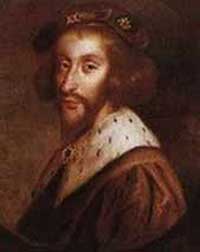
Alexander III was King of Scotland from 1249-1286, becoming king at the age of 8. He was one of Scotland’s greatest kings, gaining control of the western isles from Norway being among his many achievements.
Though his reign was relatively peaceful (about as peaceful as this period could ever be described). His personal life was anything but. He had married Princes Margaret of England – the daughter of Henry III in 1251 but she died in 1274. All three of their children died within a year leaving the King with no heir. As a backup plan Alexander convinced the estates to recognise his granddaughter Margaret, ‘The Maid of Norway’ as heir presumptive. However he really needed a male heir so quickly married Yolande de Dreux on 1 November 1285.
On the night of 19th March 1286 Alexander was feasting at Edinburgh castle. He was anxious to return to his young wife who was over the river Forth in Fife as it was her birthday the following day, it was a terrible night and his advisors urged him to wait till morning. Alexander would hear none of it and demanded they set off. Riding in the dark he became separated from his guards, Although nobody can say for sure, the best guess is that his horse lost its footing on a steep coastal embankment and he was thrown down to the shore. His body was discovered the next morning near Kinghorn, his neck broken.
Queen Yolande’s child was stillborn and the line of succession passed to Margaret but on the sea voyage to Scotland she too tragically died. So that’s 6 deaths and were only at number 1.
Scotland was plunged into turmoil, Edward I of England seized the opportunity by interfering on the reign on John Bailiol and the Wars of Scottish Independence began.
James Crichton 1560 – 1582
(Stabbed by his pupil)
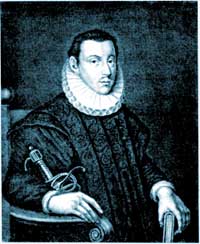
James Crichton was son of the Lord Advocate of Scotland. He is better known as ‘the Admirable Crichton’ due to his incredible mental and physical agility. By the age of twenty he was an expert in just about every field and had mastered around ten languages. If that wasn’t enough he was also renowned for his horsemanship and sword skills.
With such impressive attributes the young man naturally moved to Paris where his charm could be put to good use, he ran intellectual rings round the city’s professors and next day won a jousting competition. On a visit to Rome he impressed the Pope and the Duke of Mantua. So much so that the Duke asked him to be tutor to his son, Vincenzo.
Crichton, was naturally a success with the ladies and became a challenger for the affections of Vincenzo’s girlfriend. Alas Italian youths are much like any other hormonal youths and less than impressed with such things. In 1582 while Crichton was attending a carnival he was ambushed by a masked gang. He rapidly dispatched five of them and was preparing to finish the sixth when he revealed himself as young Vincenzo. Crichton, forever the gentleman, offered his sword and kneeled before the young Vincenzo. Vincenzo however hadn’t quite picked up on the whole ‘chivalry’ thing and promptly stabbed him with it.
James I (1406-1437)
(Murdered in a sewer)

Being a 15th Century Scottish Monarch should have come with a health warning. James’ older brother was starved to death as a prisoner at Falkland Palace. When James’ father died in 1406 he was sent to France for his own protection, however he was captured by English pirates in the way and was kept as a hostage by Henry IV. The Duke of Albany became regent and seemed in no great rush to secure the release of the King. It took him 18 years to get round to coughing up a ransom. When James finally returned to Scotland to be formally crowned at Scone in 1424 he was not a happy bunny.
Albany and his family were rounded up and the duke was executed. This didn’t end James’ problems though, many Scots nobles contested that his succession was disputed from the line of Robert II.
James met a sticky end in 1437 and the game of tennis was to blame. He was a keen player of the game but was frustrated that the balls kept falling into a sewer where he played at Friars Preachers Monastery in Perth. He had ordered that the sewer opening be blocked up. Three days later a group of Scots led by Sir Robert Graham attacked the king, James attempted to escape through the sewer but was confounded by the blocked entrance. The plot ultimately failed and when James II took the throne most of the conspirators were rounded up and put to death. Not that James II would fare much better…
James II (1437-1460)
(Blown up by his own cannon)

Known as ‘Fiery Face’, not because of his temper (though that’s debatable) but due to a red facial birthmark. He became king at age 6 and had his work cut out for him having to take care of several threats to his reign. One of the most notorious of these was the ‘Black Dinner’ In 1440 at Edinburgh Castle where he took care of the young William Douglas, 6th Earl of Douglas and of his brother. Yes in 15th Century Scotland it wasn’t even safe to sit down to supper.
The defence of his right to rule dominated much of his time as king with many campaigns fought against the potential usurpers. James was a big fan of the modern artillery advances of the time and used them to great effect in several sieges. In 1460 he was attacking Roxburgh castle which was being held by a leftover English force. On August 3rd he was overseeing a cannon barrage when one of the cannons exploded beside him killing him instantly. The Scots carried on with the siege and took the castle.
Sir Thomas Urquhart of Cromarty (1611–1660)
(Died Laughing)
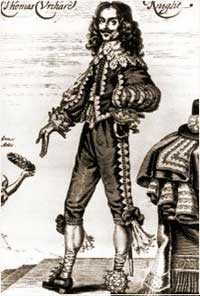
Urquhart must have been a thoroughly likeable chap. Born into a large landholding family at Cromarty in the north of Scotland he was a committed Royalist, a supporter of Charles I he was knights by the ill fated King sometime around 1640. He participated in a Royalist uprising in 1648 and was declared a traitor by parliament. He fought alongside Charles II at the battle of Worcester but was captured and taken to the Tower of London.
Unlike many others who would come to a rather abrupt termination at the ‘Bloody Tower’ Urquhart seems to have got on very well with his captors and after a brief spell at Windsor, Cromwell, not someone best known for leniency decided to parole him. Thomas Urquhart who had completed a number of interesting works in his time; a political treatise, a work on the possibility of a common global language and his most celebrated, a translation of Rabelais retired to Europe.
Sometime around 1660 news reached him of the Restoration of Charles II. he broke into a fit of excited laughter and promptly fell over dead.
Henry Stuart, Lord Darnley (1545-1567)
(Blown up and strangled)

Darnley, the eldest son of the 4th Earl of Lennox was raised in England as a Protestant during Elizabeth I’s reign. In Scotland, his besotted cousin Queen Mary gifted him the Earldom of Ross and the Dukedom of Albany, followed soon by her hand in marriage on the 29 July 1565.
Scottish nobles suspected his motives and were proven correct. His arrogance at once created great friction and in March 1566 he led a conspiracy that had David Rizzio, the Queen’s secretary and best friend, murdered before her.
After they had a son together, James VI, he began to plan how, through foreign support and changing his religion to Catholicism, he could take the Crown of Scotland from his estranged wife.
Darnley was the perfect rogue, but he was weakened by syphilis and could not pursue his goals without first convalescing. While resting at Edinburgh’s Kirk o’Fields on 10 February 1567 the house was blown up. Darnley was found strangled in the garden.
Oran of Iona (circa 560)
(Buried alive)
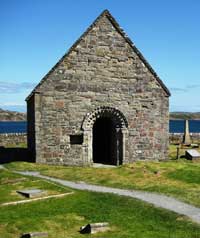
Oran was a monk from the area of Tipperaray in Ireland. He left Ireland to join St Columba who was setting up his religious community at Iona.
The legend goes that Columba was having problems constructing a chapel on the island. Every day the builders would work on the construction of the walls and the next morning would arrive to find the walls reduced to rubble. This continued until Columba heard a voice which told him that the chapel could only be completed if a living man was buried under the foundations.
Oran graciously volunteered to be buried under the chapel and the building work continued without a hitch. However one day Columba decided to have a look under the chapel floor to see what had become of poor Oran. Much to his surprise Oran was alive and well and began raving that there was no heaven or hell and attempted to climb out.
Columba called quickly for some workmen who filled the pit in before Oran could escape.
The interesting thing about this tale is that it hints back to older pagan beliefs of foundation sacrifices which were more common in Europe.
Sigurd the Mighty (circa 880)
(killed by a severed head)
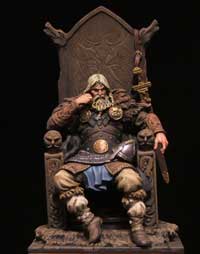
Sigurd Eysteinsson was the Earl of Orkney at a time when these islands were under Norse Control. He had an ongoing feud with a native King Máel Brigte the Bucktoothed. In order to settle the contest once and for all they both agreed to a 40 man aside battle.
Both sides turned up on the appointed day but Sigurd arrived with 80 men instead of 40. with no referee to stop him fielding 40 ineligible players Sigurd easily won the battle and took his enemy’s head as a trophy. In triumph Sigurd strapped the severed had to his horse and galloped away, but Máel Brigte was not done with him yet. As the head bounced around on the back of his horse Máel’s buck tooth scratched the back of Sigurd’s leg. The wound became infected and Sigurd died shortly afterwards.
James Douglas, 4th Earl of Morton (1516 – 1581)
(Executed by his own device)

Douglas was a powerful nobleman from the time of the ‘Rough Wooing’, a time when Henry VIII was taking a rather unhealthy interest in Scotland. He had originally conspired with Henry but came to his senses and helped defend Dalkeith Palace against the English. He was captured in 1548 and “sore hurt on the thigh” (this is Tudor euphemism for being given a good hard kick in the nuts). In 1550 when peace broke out James was returned to Scotland as part of a hostage exchange. In 1563 now Earl of Morton he was also made Lord Chancellor of Scotland.
in 1565 he was one of the lead conspirators to the murder of Mary, Queen of Scots’ friend David Rizzio. After Mary fled Scotland the country was ruled by regents on behalf of her Infant son James, in 1572 he achieved the role of Regent of Scotland himself after those before him in the queue all departed this world.
He continued successfully in this role until in 1580 he was implicated in the murder of Henry, Lord Darnley. For this he was sentenced to be executed.
Back in 1563 the ceremonial execution sword in Edinburgh had seen better days and frankly with the amount of use it had been getting really needed to be retired. Morton had seen a device in England called a Halifax Gibbet – an early form of Guillotine and had ordered that one be constructed in Edinburgh called ‘The Maiden’ to streamline the removal of heads from shoulders.
on June 2nd 1581 Morton got to find out just how effective ‘The Maiden’ was when he was its unwilling customer. His head stuck around on a spike by St Giles for 18 months before reuniting with his body at Greyfriars Kirk. Now some will tell you that the Maiden was really introduced by Edinburgh Council but never let the facts get in the way of a good story.
The Brahan Seer (circa 17th Century)
(burned in a spiked tar barrel)
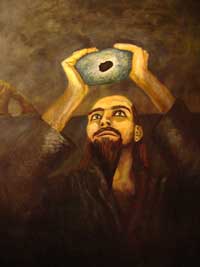
Also known is Scots Gaelic as Coinneach Odhar, or Kenneth Mackenzie he was a seer (predictor of the future). It was thought he came from Uig on Lewis and lived on lands belonging to the Seaforth MacKenzies near Dingwall. He had gained the gift of prophesy after finding an ‘adder stone’, a stone with a hole in the centre which he could use to make predictions by peering through.
Dozens of predictions relating to the highlands have been attributed to him, including the highland clearances and the building of the Caledonian Canal.
He quickly became a regular fixture at the household of the powerful MacKenzie family and this association was to prove his undoing. One evening lady Isabella Seaforth (from all accounts not what you would call ‘a looker’) asked him to tell her how her husband who was engaged in business in Paris at the time was fairing. His answer was that he was doing well and would not elaborate further – Isabella was enraged and demanded to know more, finally he told her he was doing much better than OK and was having a pretty good time with the better looking ladies of Paris.
Naturally this didn’t go down well and he was dragged from the hall and thrown head first into a barrel of burning tar.
Before he was dispatched though the seer cursed the house of Seaforth and predicted that the last of the line would be born a deaf mute. Francis Humberston Mackenzie, deaf and dumb from scarlet fever as a child, became heir in 1783. He had four children who all died prematurely fulfilling the seers prophesy.

I have a great-great grandfather that was born in Scotland but moved to nova scotia and was buried there. I don’t have date in front of me now, but named Samuel A Mckenzie. Are last name was changed by my grandfather to Mackenzie. Is there any help that might help me with the rest of our family.
Isn’t that funny. My name Mc Kenzie was spelled wrong when my great grandmother emigrated from Scotland to New York City. It is actually Mac Kenzie. Oh well. I enjoy these stories. Seeing the beauty of Scotland makes me want to go there very much.
i was told i have family over there surnames are as followed fulllertown/fullerton,and other archerbul fullerton was my 3 great grandfather the family owned a castle that queen mary stayed in before she lost her head that’s what i was told (light in the darkness)
Wonderful history lessons that you have shared with us….Thanks for the stories!
My grandfather was Robert Sowerby who came from Inverness. Is Inverness found on a mountain? If so what is its name?
Is there a river nearby? What is its name?
Castle Urchardt is on the western edge Loch Ness. Is there any other waterway such as a river, near by?
I plan to make a trip to Scotland and I am looking for traces of my family so I can take a history trek.
My grandfather, Robert Sowerby, came from Inverness. He was a master mariner, the captain of a steam driven cruise ship, called Karoola. It was converted into a hospoital ship in WW1. I was told he led a fleet of hospital ships to the Dardenelles to pick up wounded and the ANZAC troups that were withdrawing. This is all I know of my fathers family. He spoke very honourably of his grandfather. If there is any knowledge of the family either from the past or present. I would like to know of any details that anyone may know of.
I know the Karoola came into Sydney about the middle of 1915 or 1916. My father was born at the docks or in a Sydney hospital. The captains wife, Liza died as a result of the birth. So, you see the mystery of finding our Scotish family has been hard to find.